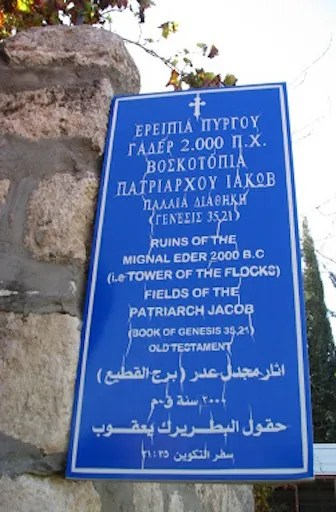Never have there been such vague directions as those given to the shepherds by the angel on the night Jesus was born. They received a sign — the baby would be wrapped in swaddling cloths and laid in a manger, a stone feeding trough. But where would they find this manger? The angel didn’t need to tell them, because they already knew.
The Tower of Eder is called Migdal Eder in Hebrew. It is the watchtower the shepherds used to protect their vast flocks on the hillsides outside Bethlehem. These were no ordinary sheep. They were to produce the lambs that would be sacrificed at the Temple of Jerusalem. According to the Talmud (Rabbinic Jewish texts) these perfect, unblemished lambs were to be born and raised on the hillside south of Jerusalem, outside Bethlehem. When a ewe was ready to give birth to her lamb, she was brought into the lower level of the Migdal Eder. This area was kept ceremonially clean.
Approximatey two miles from Migdal Eder, the Church of the Nativity is built over a cave believed to be the site of the Nativity, but the Gospels say nothing about a cave, only that there was no room for them at the inn. Perhaps the reason there was no room at the inn was the knowledge that Mary’s impending childbirth would result in bloodshed, rendering the area unclean. Rather than giving birth to the Son of God in the unclean surroundings of a stable behind the inn, the symbolism is astounding: the perfect, unblemished Lamb of God — the ultimate sacrificial lamb — born into ceremonial cleanliness, and wrapped in swaddling cloth — like the shepherds did with the perfect, unblemished lambs — and laid in the manger there, where they would know exactly where to find Him.
Bethlehem is an ancient town, dating all the way back to Jacob, and even earlier. It is the site where not one, but two notable women gave birth. Centuries before Mary and Joseph travelled here on their way to the census of Augustus, Rachel died in childbirth after delivering her son, Benjamin. Genesis 35:17-20 tells us that Jacob buried her on the way to Bethlehem (the ancient name was Ephrath.) He put a pillar over her tomb, and camped beyond the tower of Eder.
The ruins of the tower can still be seen:
Surprisingly, the tower is part of Micah’s Messianic prophecy:
“And thou, O tower of the flock, the strong hold of the daughter of Zion, unto thee shall it come, even the first dominion; the kingdom shall come to the daughter of Jerusalem.”
Micah 4:8

You must be logged in to post a comment.